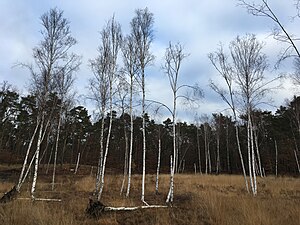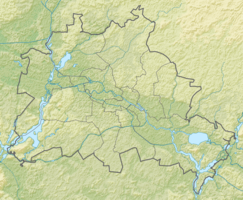Teufelsseemoor Köpenick
|
Teufelsseemoor Köpenick
|
||
|
Teufelsseemoor in Berlin-Koepenick |
||
| location | Berlin-Koepenick , Germany | |
| surface | 6.45 ha | |
| WDPA ID | 555518913 | |
| Natura 2000 ID | DE3547302 | |
| Geographical location | 52 ° 25 ' N , 13 ° 38' E | |
|
|
||
| Setup date | September 12, 2016 | |
| administration | Berliner Wasserbetriebe | |
The Teufelsmoor Köpenick is a 6.45 hectare nature reserve and Natura 2000 area in the Berlin district of Köpenick in the Treptow-Köpenick district .
location
The nature reserve is located in the southwest of the district . To the north, the Müggelheimer Damm , coming from the northwest, runs south-eastwards along the Müggelsee . South of the area is the Müggelberge ridge with the Kleiner Müggelberg in the western area and the Großer Müggelberg in the eastern area. The nature reserve is located north of this ridge at the foot of the Müggelberge and south of the Müggelheimer Damm.
Emergence
The region was formed by advancing glaciers during the last Vistula Ice Age . They were compressed by the pressure of the ice; When it melted , a dead ice hole was created that was filled with melt water . This created a boiler bog ; so it has no natural drainage. Over the centuries, layers of peat up to 13 meters thick formed . They emerged from a fen that was initially fed by groundwater. Due to dying plants, contact with the groundwater was lost and a raised bog formed in these areas. Nutrient-poor rainwater led to the formation of an oligotrophic intermediate bog .
After the Second World War , workers brought around 8,000 tons of rubble, slag and tar into the bog. This extended the run-out of the toboggan run into the Teufelssee. These contaminated sites were removed from the bog in 2003. The costs amounted to 371,000 euros.
Construction and development

In the southwest of the protected area is Teufelssee , the former dead ice hole filled with water. This is followed by a silting zone to the north and west, on which reeds thrive and merge into the moor. There peat moss and Kleinseggenriede grow .
A lowering of the groundwater level leads to increased water shortages in the bog. This leads to an increase in pine and birch trees , which eventually lead to siltation. Alder forests grow on these areas . As part of an environmental relief project, the Berlin Forests removed numerous woody plants from the moor in the winter of 2014/2015 in order to slow down silting up. The increased solar radiation should continue to support the growth of light-loving species such as sundew .
fauna and Flora
The Teufelssee is particularly the habitat of the bitterlings , while the shore zones are populated by the northern crested newt , the moor frog and the common toad . The great moss maiden was also found in the area . Under protection are further down the grass snake and the grave beetles
Tourist use
Since 2015, the moor can be crossed on a 300 meter long walkway. It replaced a previous building that was around 25 years old and had become dilapidated. The plans for the new building had been in place since 2013, but could not be implemented until two years later due to technical problems: In the 1970s, rubble was used to anchor the footbridge, which first had to be recovered and disposed of. Then 240 piles made of larch wood could be anchored up to eight meters deep in the ground, on which the new footbridge rests. The costs amounted to around 900,000 euros. The Berlin Forests have set up a nature trail on the edge of the moor . The Teufelssee teaching cabinet of the Berlin Forests is located north of the protected area.
literature
- Ordinance on the "Teufelsseemoor Köpenick" nature reserve in the Treptow-Köpenick district of Berlin of September 12, 2016, published in the Law and Ordinance Gazette for Berlin, Volume 72, No. 26, September 29, 2016, p. 771
Web links
- NSG and NATURA 2000 area Teufelsseemoor Köpenick , website of the Senate Department for the Environment, Transport and Climate Protection, accessed on January 10, 2019.
Individual evidence
- ↑ Teufelsmoor at the foot of the Müggelberge renatured , press release of the Berlin Senate from May 6, 2003, accessed on January 10, 2019.
- ↑ Ralf Drescher: The new footbridge leads through the Teufelsmoor . In: Berliner Woche , December 18, 2015, accessed on January 10, 2019.



